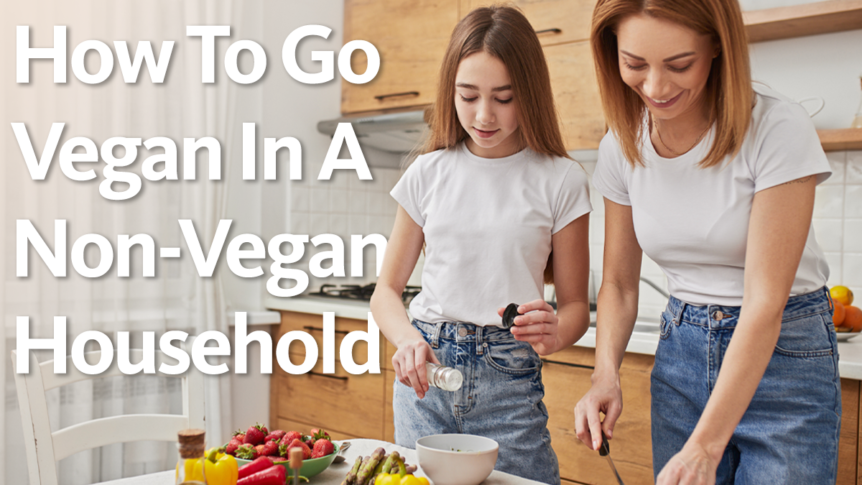Going vegan is a big step and a really significant lifestyle change, but it is so important for animals, the environment, and your health. Your decision to live a kinder life not only affects you but those closest to and living with you. While making this change is very rewarding, it can be challenging at times, and having the proper support can make the transition all that much easier.
So what do you do when your loved ones are big meat eaters? Here’s a few tips and strategies to make your switch to veganism as smooth and havoc-free as possible, and most importantly, enjoyable. I used my own experiences and the stories of others to help create this guide to aid you in communicating with and balancing the dietary change with the lifestyles of non-vegan households. These are a few things I wish we’d known before I went vegan in my non-vegan family.
1. Let everyone in your household know of your new dietary change
The first and probably most important thing you should do before going entirely vegan is to let your loved ones know. That way everyone can be prepared, and not be upset when you don’t eat their non-vegan dishes. Making everyone aware of your new lifestyle can make the shift much easier, and is the best way to start your veganism on the right foot. Tell them about why you’ve become vegan, and let them know you don’t expect anything of them other than their open-mindedness and support.
2. Make note of all the vegan products you already have in your household and what you’ll need to buy
You’ll be surprised at how many of the food items you have in your pantry are already vegan-friendly. Twizzlers, Cliff Bars, Peanut Butter, and even Oreos are all foods you are familiar with that are entirely vegan. Take inventory of your fridge so that you can begin to incorporate these foods into your meal plan. Beyond that, start researching new snacks and foods you plan to include in your diet so that you can stock up. You should also start to look for vegan alternatives for your favorite comfort foods. That way when you switch, you won’t struggle as much with missing your favorite dishes. Thankfully, due to the massive increase in popularity of veganism today, there is a wide array of vegan products and alternatives available that taste almost exactly the same.
3. Establish a meal plan that aligns well with foods already eaten by your household, and also fulfills all of your dietary needs; Meal Prep
Building upon the last tip, it’s crucial that you establish a meal plan that fulfills your dietary needs in a way that aligns with those around you as much as possible. Going vegan for the first time, it’s easy to fall into a diet that is incredibly carbohydrate heavy. There are certain vitamins and minerals that are more difficult to source from a vegan diet than from the traditional carnivorous diet. That said, armed with the proper knowledge and research, you can easily establish a meal plan that hits all of the bases as well as being vegan-friendly. You can plan out your meals hours, and even days in advance. Start with your favorite meat dishes, and just swap out the meat for a plant-based alternative such as tofu, seitan, or even portobello mushrooms. That way you never have to struggle with your next meal; it’s already waiting in your fridge.
4. Become involved in grocery shopping for the household if you aren’t already
Who’s usually the one in your household that buys the groceries? Maybe next time they go on a shopping trip, offer to join them. Become an active participant in the grocery shopping for your family, because if you don’t buy the vegan options, chances are no one else will. In my experience, I’ve found that whoever has the most restricted diet or is simply the pickiest in their food choices should contribute the most to groceries. It relieves some of the pressure on the shopper to find ingredients that fit your exact needs and allows you to have a little bit more control over what’s in your house.
5. Last, but not least, make some vegan dishes for the whole household that you think everyone will enjoy
I’ve found that this is one of the best things you can do as a vegan surrounded by meat-eaters. Show off your culinary skills by making a hearty vegan soup, or prove to everyone a vegan burger can be just as tasty by making these truffle bean burgers. Of course, make the entire experience optional and most importantly enjoyable. Don’t force anyone to try your vegan dishes, and try to not be offended if your family members refuse to. Oftentimes vegans are stereotyped as being imposing and spiteful of meat-eaters, so make sure to be open and accepting of everyone around you. That being said, a great vegan dish can be a great way to bring the household together, and help others see that being vegan can be truly delicious. Perhaps your culinary creation will get another person in your household to switch to a plant-based diet with you.

